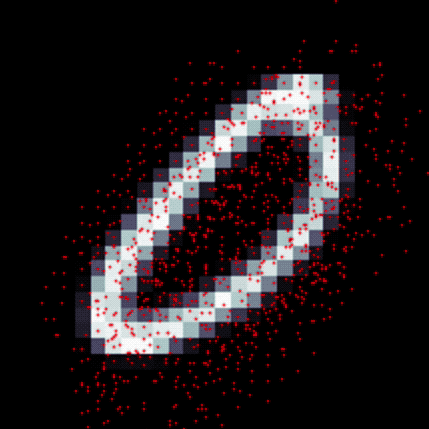- Thanks to offical code: https://github.com/msracver/Deformable-ConvNets
faster rcnn(resnet50) result is implemented without OHEM and deformable roi pooling
train with pascal voc 2007 + 2012 test on 2007
| mAP@0.5 | aeroplane | bicycle | bird | boat | bottle | bus | car | cat | chair | cow |
|---|---|---|---|---|---|---|---|---|---|---|
| 0.7811 | 0.7810 | 0.8560 | 0.7828 | 0.6910 | 0.5948 | 0.8430 | 0.8741 | 0.8878 | 0.6213 | 0.8347 |
| diningtable | dog | horse | motorbike | person | pottedplant | sheep | sofa | train | tv |
|---|---|---|---|---|---|---|---|---|---|
| 0.7324 | 0.8695 | 0.8893 | 0.8507 | 0.7986 | 0.5226 | 0.7791 | 0.7933 | 0.8528 | 0.7668 |
The MNIST example is in caffe/defor/
Compile:
mkdir build cd build cmake .. make allTrain & test:
cd caffe/defor/
./train_lenet.sh
and the model is in caffe/defor/model_protxt/
Train &test:
./experiments/scripts/faster_rcnn_end2end.sh 0 ResNet50 pascal_voc
./test.sh 0 ResNet50 pascal_vocAll codes are in deformable_conv_cxx/
optional DeformableConvolutionParameter deformable_convolution_param = 999;
message DeformableConvolutionParameter {
optional uint32 num_output = 1;
optional bool bias_term = 2 [default = true];
repeated uint32 pad = 3; // The padding size; defaults to 0
repeated uint32 kernel_size = 4; // The kernel size
repeated uint32 stride = 6; // The stride; defaults to 1
repeated uint32 dilation = 18; // The dilation; defaults to 1
optional uint32 pad_h = 9 [default = 0]; // The padding height (2D only)
optional uint32 pad_w = 10 [default = 0]; // The padding width (2D only)
optional uint32 kernel_h = 11; // The kernel height (2D only)
optional uint32 kernel_w = 12; // The kernel width (2D only)
optional uint32 stride_h = 13; // The stride height (2D only)
optional uint32 stride_w = 14; // The stride width (2D only)
optional uint32 group = 5 [default = 4];
optional uint32 deformable_group = 25 [default = 4];
optional FillerParameter weight_filler = 7; // The filler for the weight
optional FillerParameter bias_filler = 8; // The filler for the bias
enum Engine {
DEFAULT = 0;
CAFFE = 1;
CUDNN = 2;
}
optional Engine engine = 15 [default = DEFAULT];
optional int32 axis = 16 [default = 1];
optional bool force_nd_im2col = 17 [default = false];
}you can read the template in deformable_conv_cxx/caffe.proto
move deformable_conv_layer.cpp and deformable_conv_layer.cu to yourcaffepath/src\caffe\layers\
move deformable_conv_layer.hpp to yourcaffepath/include\caffe\layers\
move deformable_conv_layer.hpp to yourcaffepath/include\caffe\layers\
move deformable_im2col.cu to yourcaffepath\src\caffe\util\
move deformable_im2col.hpp to yourcaffepath\include\caffe\util\mkdir build cd build cmake .. make allThe params in DeformableConvolution:
bottom[0](data): (batch_size, channel, height, width)
bottom[1] (offset): (batch_size, deformable_group * kernel[0] * kernel[1]*2, height, width)
Define:
f(x,k,p,s,d) = floor((x+2*p-d*(k-1)-1)/s)+1
the output of the DeformableConvolution layer:
out_height=f(height, kernel[0], pad[0], stride[0], dilate[0])
out_width=f(width, kernel[1], pad[1], stride[1], dilate[1])
Offset layer:
layer {
name: "offset"
type: "Convolution"
bottom: "pool1"
top: "offset"
param {
lr_mult: 1
}
param {
lr_mult: 2
}
convolution_param {
num_output: 72
kernel_size: 3
stride: 1
dilation: 2
pad: 2
weight_filler {
type: "xavier"
}
bias_filler {
type: "constant"
}
}
}DeformableConvolution layer:
layer {
name: "dec"
type: "DeformableConvolution"
bottom: "conv1"
bottom: "offset"
top: "dec"
param {
lr_mult: 1
}
param {
lr_mult: 2
}
deformable_convolution_param {
num_output: 512
kernel_size: 3
stride: 1
pad: 2
engine: 1
dilation: 2
deformable_group: 4
weight_filler {
type: "xavier"
}
bias_filler {
type: "constant"
}
}
}the prototxt model should like:
The following animation is generated by Felix Lau (with his tensorflow implementation):https://github.com/felixlaumon/deform-conv/
- all tests passed
- evaluate performance on Regular MNIST
- evaluate object detection performance on voc
Dai, Jifeng, Haozhi Qi, Yuwen Xiong, Yi Li, Guodong Zhang, Han Hu, and Yichen Wei. 2017. “Deformable Convolutional Networks.” arXiv [cs.CV]. arXiv. http://arxiv.org/abs/1703.06211

